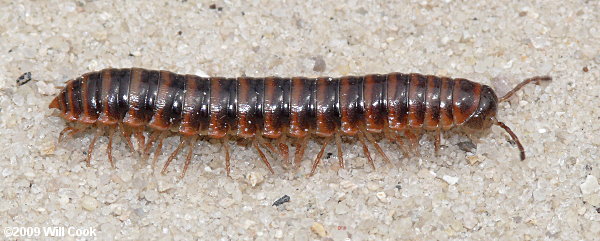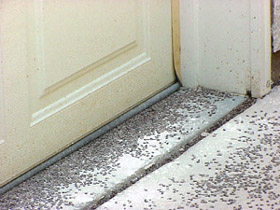 Millipedes
are common occasional pests that sometimes
invade buildings, particularly when the weather
turns hot and dry. While millipedes sometimes
enter in large numbers, they do not bite, sting,
or transmit diseases, nor do they infest food,
clothing or dry, structurally sound wood.
Millipedes vary in both color and size. The most
common species that invades buildings is the"
garden millipede", which is brownish-black in
color and about one inch long. When
disturbed, millipedes often curl up into a "C"
shape and remain motionless. They crawl slowly
and protect themselves by secreting cyanide-like
compound that has an unpleasant odor . Some
people confuse millipedes with centipedes, which
look somewhat similar. Centipedes have only one
pair of legs per body segment and the legs are
usually longer than those on millipedes.
Centipedes also tend to move about more quickly
than millipedes.
Millipedes
are common occasional pests that sometimes
invade buildings, particularly when the weather
turns hot and dry. While millipedes sometimes
enter in large numbers, they do not bite, sting,
or transmit diseases, nor do they infest food,
clothing or dry, structurally sound wood.
Millipedes vary in both color and size. The most
common species that invades buildings is the"
garden millipede", which is brownish-black in
color and about one inch long. When
disturbed, millipedes often curl up into a "C"
shape and remain motionless. They crawl slowly
and protect themselves by secreting cyanide-like
compound that has an unpleasant odor . Some
people confuse millipedes with centipedes, which
look somewhat similar. Centipedes have only one
pair of legs per body segment and the legs are
usually longer than those on millipedes.
Centipedes also tend to move about more quickly
than millipedes.
Life Cycle and Habits
 Millipedes
pass the winter primarily as adults and lay
their eggs in the soil in the spring.
Individuals may live for several years.
Millipedes are attracted to dark, cool, moist
environments that are rich in organic matter
such as compost piles, heavily mulched shrub or
flower beds, rotting logs, or the soil under
logs and stones. They usually go unnoticed
because they live in these relatively hidden
habitats. Millipedes are scavengers, feeding
primarily on decomposing vegetation, but
occasionally they will damage soft-stemmed
plants in gardens. Major nuisance problems
usually occur when the conditions become too hot
and dry and the millipedes move to find
moisture, or else when it's too wet and
water-saturated soils force them to the surface
and higher ground where they often end up on
concrete slabs, foundations and siding.
Millipedes may also migrate in the fall,
presumably in search of overwintering sites. All
of these activities result in millipedes
invading crawl spaces, basements and other areas
of buildings. Common points of entry include
door thresholds (especially at the base of
sliding glass doors, garage doors), expansion
joints, and through the voids of concrete block
walls. Frequent indoor sightings of these pests
usually means that there are large numbers
breeding outdoors in the lawn, or beneath mulch,
leaf litter or debris close to the foundation.
Millipedes do not survive indoors for more than
a few days (more likely just a few hours) unless
they can find suitable moist conditions.
Millipedes
pass the winter primarily as adults and lay
their eggs in the soil in the spring.
Individuals may live for several years.
Millipedes are attracted to dark, cool, moist
environments that are rich in organic matter
such as compost piles, heavily mulched shrub or
flower beds, rotting logs, or the soil under
logs and stones. They usually go unnoticed
because they live in these relatively hidden
habitats. Millipedes are scavengers, feeding
primarily on decomposing vegetation, but
occasionally they will damage soft-stemmed
plants in gardens. Major nuisance problems
usually occur when the conditions become too hot
and dry and the millipedes move to find
moisture, or else when it's too wet and
water-saturated soils force them to the surface
and higher ground where they often end up on
concrete slabs, foundations and siding.
Millipedes may also migrate in the fall,
presumably in search of overwintering sites. All
of these activities result in millipedes
invading crawl spaces, basements and other areas
of buildings. Common points of entry include
door thresholds (especially at the base of
sliding glass doors, garage doors), expansion
joints, and through the voids of concrete block
walls. Frequent indoor sightings of these pests
usually means that there are large numbers
breeding outdoors in the lawn, or beneath mulch,
leaf litter or debris close to the foundation.
Millipedes do not survive indoors for more than
a few days (more likely just a few hours) unless
they can find suitable moist conditions.
